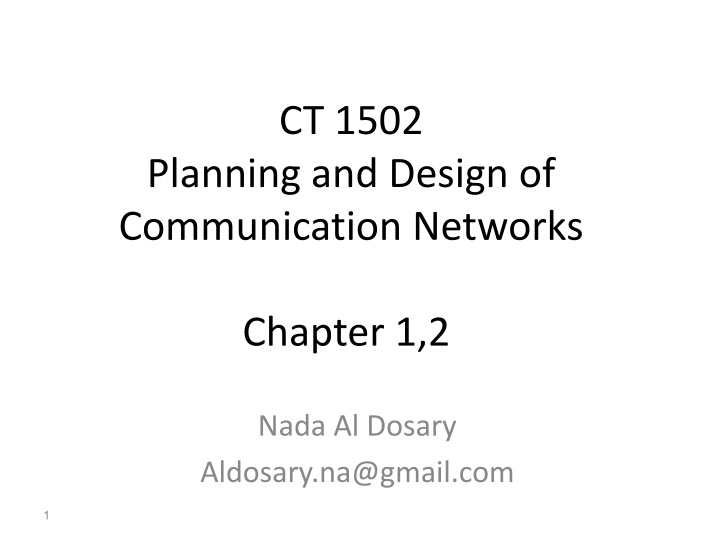
Communication Networks: Planning, Design, and Benefits
Explore the fundamentals of communication networks, including sharing in different kinds of networks, benefits such as efficiency and reliability, and the main components of communication systems like data transmission and communication channels.
Download Presentation

Please find below an Image/Link to download the presentation.
The content on the website is provided AS IS for your information and personal use only. It may not be sold, licensed, or shared on other websites without obtaining consent from the author. If you encounter any issues during the download, it is possible that the publisher has removed the file from their server.
You are allowed to download the files provided on this website for personal or commercial use, subject to the condition that they are used lawfully. All files are the property of their respective owners.
The content on the website is provided AS IS for your information and personal use only. It may not be sold, licensed, or shared on other websites without obtaining consent from the author.
E N D
Presentation Transcript
CT 1502 Planning and Design of Communication Networks Chapter 1,2 Nada Al Dosary Aldosary.na@gmail.com 1
Sharing in deferent kinds of networks Networks Shared resource Ways to share Transportation networks roads transportation Electricity networks energy wires Water networks water water pipes computer systems, sending and receiving devices and channels data (images, text, voice, etc) Computer networks 2
Networks benefits Efficiency: rapid of procedure completion, (save time), reduce movement, save paper, save room, etc. Quality: accuracy( ), Integration( ) and homogeneity( ), Reliability( security( ), etc. New development opportunities: expand information resources, support making decision, Provide unprecedented possibilities that opens new horizons for new business. )and 3
Fundamentals of communication networks 4
Main Components of Communication Systems Communications: is the act of exchanging information between two or more users in form of letters, words, message, images, voice, etc. Data Transmitter Receiver communication channel 5
Main Components of Communication Systems Data: Analog Data: data represented in a continuous form, similar to its original structure (voice, video, etc). Digital Data: data that are electromagnetically stored in the form of discrete digits (zeros and ones). 1 0 analog data digital data 6
Main Components of Communication Systems Transmitter and Receiver: Transmitter: send data in electrical form (signals) across communication channel. Receiver: receive the signals across the channel and restores the data from that signals. 7
Main Components of Communication Systems Communication Channels: the medium that data travel through between transmitter and receiver. Wires and Cables: communication channels that links network components using cables (twisted pair, coaxial cable, fiber optic) Wireless: communication channels that links component using electromagnetic waves to transmit data through atmosphere(microwave, radio, satellite) 8
Main Components of Communication Systems Transmission Protocol: Simplex: data transmission in only one direction(radio broadcasting, TV cable). Half duplex: data transmission in one direction at a time(walky-talky). Full duplex: data transmission in both directions simultaneously( ) (telephone). 9
Main Components of Communication Systems Signals Concept: to transmit data from one station to another it has to be modulated to (signals) that can be transmitted through channels. Analog Signals: represent data with continuously varying electromagnetic waves 11
Main Components of Communication Systems Digital Signals: represent data with sequence of voltage pulses. 12
Understanding Communication Networks Network: is a set of devices (often referred as a node ) connected by communication links. A node can be: any device can send or receive data computer, printer, router, or any other device. 13
Understanding Communication Networks Nodes: Terminal Node: generate data, use data. Communications Node: transmit data, doesn t use it 14
Categories of networks Local Area Network(LAN): private owned and links the devices in a single office, building ore campus. Wide Area Network(WAN): provides long- distance transmission of data over large geographic area (country, continent, the whole world ) Metropolitan Area Network(MAN): a network between the size of a LAN and a WAN. 15
Hardware Components Transmission Media: the medium that data travel through between transmitter and receiver. Access Device: prepare and transform data into electrical pulses that can transmit trough transmission media. send and receive data. control data follow. ex: Network Interface Card (NIC). 17
Hardware Components Repeaters: receive a network signal and regenerate and retransmit the signal as it is in its original strength. 18
Software Components Protocols: is a system of digital rules for message exchange within or between network devices. Network Operating System: software allow the connection between network and devices enable users to connect each other, share resources, in addition of manage and control the network components. Ex: Microsoft windows, Unix 19
Network Functions 1. Switching: receive data from any source connected to it and dispatch that data to the appropriate destination through multiple channels. Circuit switching technique: consists of set of switches connected by physical links. Packet switching technique: message is broken into a number of parts which are sent independently, and reassembled at the destination. 20
Network Functions 2. Routing: selecting best paths in a network the data travel through from transmitter to receiver. 3. Addressing: IP address for each device 4. Multiplexing: integrates multiple signals into a signal transmitted over a shared medium. 23
Network Functions 5. Network Management: Configuration Management Performance Management Fault Management Accounting Management Security Management 24
Network Functions 6. Other Network Functions Error Detecting and Correction Flow Control Congestion Control 25
The End The End 26
